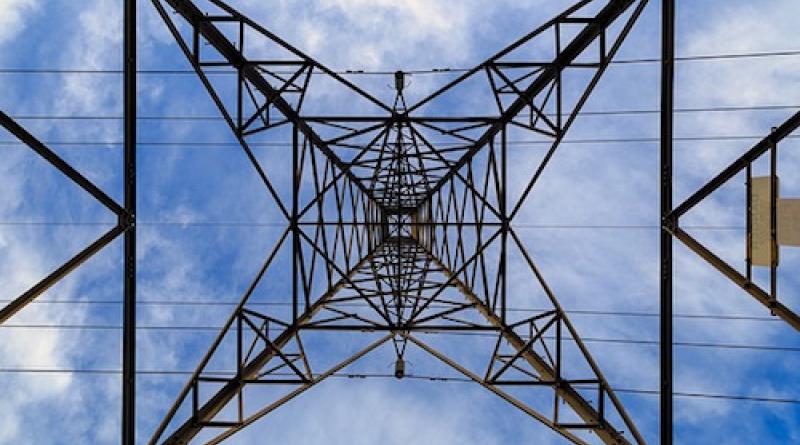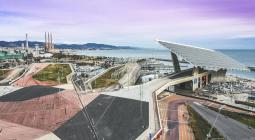Decarbonizing Energy Depends on Repairing, Expanding the Grid

The greatest barrier to new energy sources isn’t intermittency. It’s short-termism, and utilities are among the biggest sources, writes Brown University student and Sunrise Movement volunteer Eva Kappas, in a post for Climate & Capital Media.
In the United States, the collapse of Baltimore’s Francis Scott Key bridge killed six workers, was top news on every U.S. outlet for a full week, and brought a grim reminder that a third of the country’s bridges need repair or replacement. But that challenge extends equally to utility infrastructure—and in Canada no less than in the U.S
The aging of the U.S. electrical grid has been a little-noticed slow-motion accident, Kappas writes. It hasn’t brought deaths or dramatic videos—unless you count the firefighters killed while battling blazes started by an outdated grid. The impact of time and underinvestment on the grid is harder to show, but it’s massive. In 2021, the American Society of Civil Engineers (ASCE) gave the U.S. electrical grid a C- in its quadrennial energy infrastructure report card. More than 70% of grid transmission lines and transformers are over 25 years old. That makes them more vulnerable to natural disasters, which hit millions of U.S. families and cost businesses US$150 billion in 2022 alone.
In Canada, households face C$25 billion per year in climate-related losses as early as 2025, the Canadian Climate Institute reported in 2022. That total will hit $78 to $101 billion per year by 2050, depending on future greenhouse gas emissions, and $391 to $865 billion per year by the end of the century, the institute concluded in its landmark macroeconomic study, Damage Control [pdf].
In the U.S., while Silicon Valley and Wall Street chase the shiniest new climate and energy technologies, the sluggish pace of grid modernization by the utility industry and every level of government has resulted in higher energy costs, less reliability, and slower economic growth, Kappas says. That’s not to mention the escalating climate disasters, increased pollution, and health issues caused by an all-time high in fossil fuel production, enabled by a grid that is unequipped to integrate renewables. In addition to climate change, the grid is vulnerable to physical and cyber attacks, all creating national security risks.
The Surprising Benefits of Investing
The benefits of addressing these threats far outweigh the cost. “Decarbonizing the power grid by 2035 could [cost] $330 billion to $740 billion,” the U.S. National Renewable Energy Laboratory (NREL) reported. But it would save US$1.2 trillion in damage from floods, drought, wildfires, and hurricanes due to climate change, plus $400 million in the costs of premature deaths, “totalling an overall net benefit to society ranging from $920 billion to $1.2 trillion.”
Even without national security risks, new energy is needed to meet the needs of a growing and increasingly electrified society. A slew of studies forecast sharp increases in energy demand resulting from the growth of data centres sparked by artificial intelligence, manufacturing by the 2022 Inflation Reduction Act (IRA), and vehicle electrification. That’s prompted action—but nowhere near enough.
The U.S. Department of Energy (DOE) says the U.S. needs to more than double the capacity of the power grid, parts of which are more than a century old, to achieve the Biden administration’s goal of 100% renewable energy by 2035. The DOE is offering $290 million in loans for clean energy projects. The U.S. also committed $1.3 billion to help build three major transmission lines across six states, adding 3.5 gigawatts (GW) of grid capacity, enough to power three million homes and create 13,000 jobs.
However, DOE concedes the U.S. will need nearly 10 times that amount. In fact, utilities have nearly doubled their forecasts of energy demand increases over the next five years from 2.6% to 4.7%—well above the past decade’s 0.5% annual growth forecasts. The consultancy Grid Strategies in December said the U.S. will need another 38 GW by 2029.
‘We Have the Technology’
We have all the technology we need to meet this accelerating demand with renewables. Most utilities have resisted major adoption of renewables, claiming they’re too intermittent. But a recent NREL study found multiple pathways to 100% clean electricity by 2035, a White House goal, using existing technologies. The U.S. National Oceanic and Atmospheric Administration found that by siting renewables where they have the highest potential and connecting them with high-voltage transmission lines, the country can cut greenhouse gas emissions by 80% from 1990 levels in 15 years, with no new energy storage.
According to Grid Strategies, replacing 5,000 miles of old transmission lines each year with “advanced conductors” and using newer metal compounds could add an additional 27 GW of renewable generation per year. This “advanced reconductoring” can “double existing transmission line capacity at less than half the cost and a fraction of the time as new lines,” GridLab reported.
Smaller technologies can also help. “Dynamic line rating systems,” for example, use simple sensors on power lines to send real-time data on wind, temperature, and humidity to indicate when it’s safe to transmit greater amounts of power, increasing a line’s power-carrying capacity by 30 to 44%. “Smart” electrical panels and inexpensive electric meter socket adaptors such as ConnectDER’s “collars” automate the delivery of renewable power to homes and businesses. This transition is feasible and happening: renewables already comprise 86% of new utility capacity.
Interconnection Disconnect
These analyses refute utility claims that integrating renewable resources is technologically and economically infeasible. Still, the U.S. Lawrence Berkeley National Laboratory (LBNL) found that a stunning 2.5 terawatts of energy generation and storage capacity in 2023 remained stuck in “interconnection queues,” up 40% over 2022. For perspective, that’s twice the U.S. grid’s current 1.25 terrawatts of capacity. And 95% of those projects would use renewables. Most projects seeking connection to the grid are withdrawn; many cite the enormous risks and costs of unpredictable interconnection queues, which have become the single greatest barrier to the adoption of renewable energy.
The main reason many utilities have resisted renewable energy is that it alters their simple and profitable fossil fuel-based business and delivery model—and it requires up-front investment that our short-term-focused markets tend to punish rather than reward. Policy-makers at all levels—many of them funded by fossil fuel interests—haven’t sufficiently incentivized or mandated those investments.
“The U.S. provides transmission owners little incentive to deliver more power over existing lines or to reduce transmission congestion,” the U.S. Department of Energy reported. That needs to change quickly to catalyze the deployment of clean energy sources, improve our health, and stabilize our economy and environment before we accelerate extinction and other cascading effects of climate change.
Financing high-voltage, long-range transmission lines has proved a special challenge. Local and regional utilities are reluctant to commit capital given high costs, long timelines, and potential regulatory or public opposition. Interstate transmission line projects can range from US$300 million to $7 billion dollars, and take upwards of 10 to 15 years to complete. Merchant banks and entrepreneurs have stepped in. But several attempts to build new transmission in New England and to connect to Canadian hydropower have failed in the past decade amid opposition from environmental and local groups. Kappas cites a project manager from a long-range transmission construction company she spoke with who said that 10 years and $10 million dollars into a project, they might come up against an unwilling state public service commission and be forced to abandon the effort.
‘A Powerful Impact’
State and federal support can drive transmission development through direct financing, and by reducing “soft costs” such as permitting. However, governments at all levels have not yet provided the support needed to make the rapid transition we need.
The IRA championed by the Biden administration represents the greatest single push toward green energy in history. Promising a 40% reduction in emissions from 2005 levels by 2030, it effectively incentivizes the private sector to take on most of the costs and benefits of developing renewable energy generation. And that’s had a powerful impact, so far creating “523 new clean energy projects totalling 271,713 new jobs and over $352 billion in investments across 47 states,” according to the advocacy group Climate Power. That includes $370 billion to facilitate the “clean energy transition,” comprising everything from carbon capture to new boilers, heat pumps, and energy storage.
The IRA’s provisions to improve transmission lines were more modest, earmarking just $3 billion in financing for transmission improvements. But the Act’s benefits are still unfolding. For example, it will provide $2 billion in direct loans through the Transmission Facility Financing Program once the DOE identifies high-priority areas for transmission development called National Electric Interest Transmission Corridors (NEITCs). It also provides $760 million through the Transmission Siting and Economic Development (TSED) Grants Program to “provide financial support to state, tribal, and local entities that are responsible for issuing the permits needed to move forward with critical electric transmission projects.” The TSED program, however, did not address structural inefficiencies in the permitting process itself.
The 2021 Bipartisan Infrastructure Law’s Transmission Facilitation Program also allocated $2.5 billion for DOE public-private partnerships with developers. The federal Grid Resilience and Innovation Partnerships (GRIP) Program has authorized $3.5 billion out of $5 billion in total funding to 58 projects designed to enhance grid flexibility and resilience.
These investments help. But they’re a drop in the bucket compared to the $100 billion needed to help modernize the grid, not to mention the $85 billion in carbon capture and storage efforts, often a misleading and ineffective solution, and the $43 billion in incentives for electric vehicles and energy-efficient appliances. These emission-reducing initiatives depend on an expanded and updated grid.
Decarbonization Depends on the Grid
Implicit in “electrify everything” plans catalyzed by the IRA is the fact that the electricity comes from renewable energy. A 2022 report from Princeton’s ZERO lab found that “if electricity transmission cannot be expanded fast enough, power sector emissions and associated pollution and public health impacts could increase significantly as gas and coal-fired power plants produce more to meet growing demand from electric vehicles and other electrification spurred by IRA.”
The 2023 study by NREL noted that if “barriers to deployment of clean electricity or supporting infrastructure (such as transmission) are not mitigated, then the share of clean generation achieved and the associated emissions benefits realized may be substantially reduced.”
In short, the White House and Congress—which means both major parties—must do far more to expand and upgrade our grid to reduce emissions, protect our health, and facilitate economic growth.
It’s time to invest in our electrical grid like any other piece of infrastructure. As climate change intensifies, we can only tinker with the grid for so long. With every storm, heatwave, and cyber-hacking innovation, our outdated transmission system grows more vulnerable. Now is the time to repair and expand so that we can accelerate into the energy transition that will keep us moving forward—and more safely.






